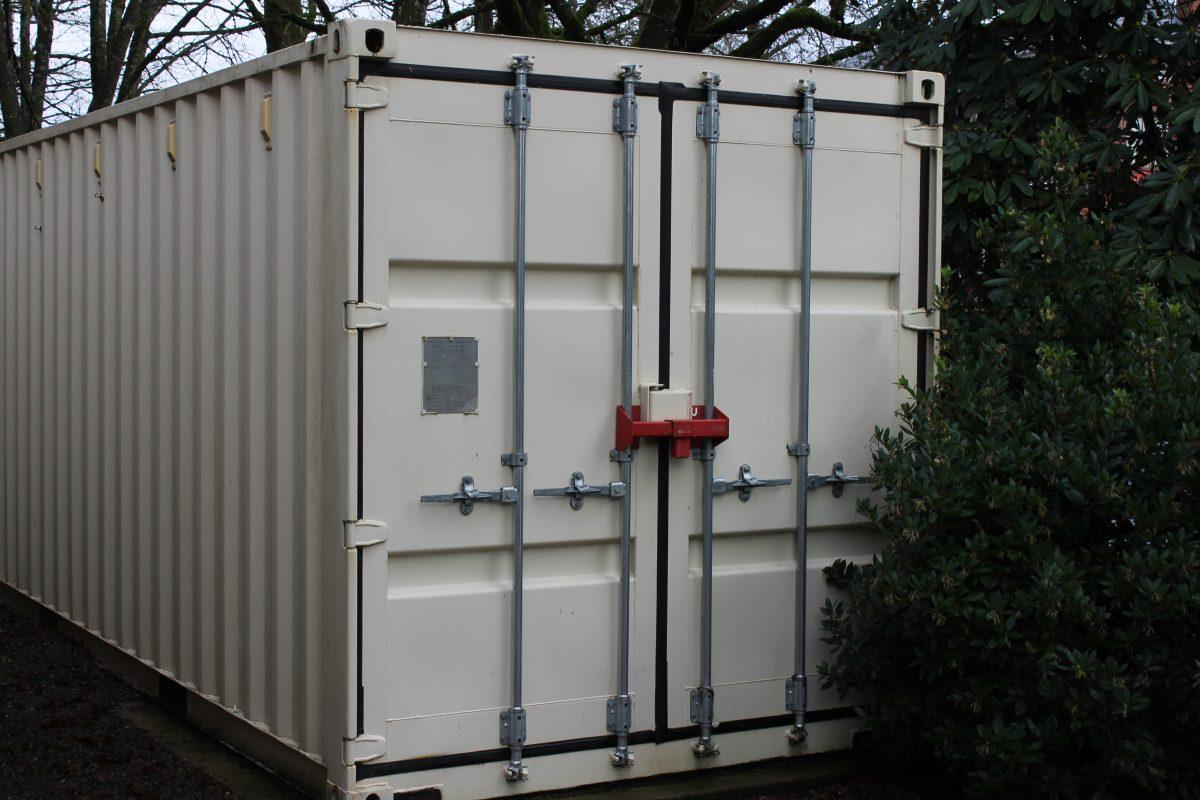
On an uncomfortably cold, wet and miserable day in early December, Dan Stefanisko stands inside a muggy storage container in the Laurelhurst neighborhood. To either side of him are wooden shelves holding first aid kits, metal chairs and flashlights; a large metal box containing radio equipment sits by the entrance. The container stores supplies for Neighborhood Emergency Response Teams, or NETs.
Stefanisko is the co-team leader for the Laurelhurst NET, one of many volunteer teams trained by the Portland Fire & Rescue Service and the Portland Bureau of Emergency Management (PBEM). In the event of an emergency, NET members across the city — dedicated volunteers motivated by their desire to help others — jump into action, searching for and helping people in need.
NETs are a part of the nationwide program known as Community Emergency Response Teams (CERT), which operates under the Federal Emergency Management Agency. The official name of Portland’s SWAT team is Special Emergency Response Team, or SERT. The local CERT name was thus changed to NET to prevent any confusion.
The idea for CERT got its start in 1985, when the Los Angeles Fire Department realized the role that ordinary civilians play in emergency response. Studies show that 90% of disaster survivors are rescued by neighbors.
“What LA Fire noticed is that people help a neighbor and they get hurt doing it … The idea is by training our volunteers in advance, they know how to respond, they know what to do and not to do,” says NET Administrator Glenn Devitt, who oversees the program. “LA was first and followed by San Francisco, and then Portland was the third program in the country to be established.”
Portland, Oregon, like the rest of the Pacific Northwest, lies in the Cascadia Subduction Zone and faces the looming threat of a 9.0 magnitude megathrust earthquake. An earthquake this large would cause devastating damage, taking down phone lines, water and sewage systems, electrical grids and major highways. Many homes, offices, grocery stores and hospitals would collapse or be damaged in some way. The earthquake would also wreak havoc on gas lines and industrial facilities. Gas leaks, fuel spillage and other emanated hazardous substances could contaminate Portland’s air, water and soil, posing additional health threats.
The sheer scale of the crisis would overwhelm fire, police and other emergency services, as infrastructure damages like collapsed buildings, cracked roads and fallen power lines would make it challenging for them to mobilize.
“In a very large emergency situation like an earthquake, it could be several days before you actually see any ambulances or fire trucks or anything like that,” says Molly Hamill, the Grant Park NET team lead.
This is where volunteer teams like NETs come in.
“What the volunteers would do is help supplement the police, so we’d go around checking on different damages (and) helping out people who need first aid,” says Stefanisko. “We’re kind of the eyes and ears until things get back to normal.”
While the team’s primary goal is to help others in emergency situations, they are taught not to put their own lives at risk. Stefanisko describes the role of a NET volunteer as “doing the most good for others, (but) not putting yourself in danger.”
NETs’ current model is based around a system with neighborhood-wide caches and command centers. Following an emergency, PBEM would authorize NETs to deploy by radio, phone call, text or other methods of communication. If a disaster is severe enough to disrupt these communication systems, NET members are instructed to self-deploy.
In a major emergency, NETs would make for their cache and staging area, which has the supplies they need to get emergency assistance systems up and running. They would then establish a command center at their cache, from which groups of NET volunteers could be tracked and sent out into the neighborhood to provide assistance.
Additionally, many NETs have Amateur Radio Operators (AROs) with two roles, according to Lee Younglove, the former ARO for the Laurelhurst NET.
“One type of Amateur Radio Operator is an unlicensed radio operator, and their function is strictly communication within the team,” says Younglove. “The other would be a licensed amateur radio operator … (who) would be communicating with the city up the chain of command to the Emergency Coordination Center.”
Becoming a NET volunteer requires completion of about 28 hours of basic training, usually in the form of four Saturday or Sunday classes. During this training, prospective NET members learn how to assess the danger of damaged buildings, set up a command center, perform search and rescue and other emergency skills. Once an official member, however, the work doesn’t stop.
Members also need to demonstrate self-sufficiency for two weeks during a disaster. This includes having plenty of water for both drinking and hygiene, and being able to support neighbors with emergency care.
NET members are required to complete 12 volunteer hours every year. There are a variety of ways to fulfill this obligation, including taking part in training and simulation exercises, educating others about emergency preparedness and taking advanced emergency training classes.
“Every week, there’s something you can do to practice or perhaps to go out and actually use your skills at a warming center, at the centers where people went to during the wildfires, at a major accident, at an electrical line being down, at a tree being down,” says Hamill.
This work helps free up standard emergency responders, allowing them to focus on more pressing calls instead of protecting a downed power line or some other minor emergency. “Rather than having an engine and four firefighters sitting there watching nothing, our NETs come and relieve them to do the work they’re trained for,” says Devitt.
Being in a NET can be a great way to both prepare oneself for an emergency and help others. However, it’s also a commitment not everybody has time for. This reality has led PBEM to change some aspects of their emergency response approach in order to supplement NETs and ensure higher levels of preparedness within Portland neighborhoods.
“(We’ve created) what’s called an ATV — Affiliated Team Volunteer — so people who are engaged with their teams and have some skills to offer but won’t go through the entire NET training …So teams now are building more of those relationships outside purely the NET requirements,” says Devitt.
PBEM also partners with Portland Public Schools to run a Teen CERT program within schools that offers emergency response training similar to NETs.
“There’s a 10-week in-class program that the teacher obviously has to request and initiate,” Devitt says. “The students would have 10 weeks of training in-school, and then we do the final field exercise at the Portland Fire and Rescue Training Center — just like our NETs do.”
PBEM and the NETs’ integration into their larger communities is essential in building a city that is prepared for whatever is thrown at them. “Establishing those ties really builds the fabric of community, both under blue skies and under good times, and also when things turn bad,” says Devitt.
In the coming years, there will likely be significant changes to the NET program to more accurately reflect the realities on the ground. Right now, NETs and where they operate in an emergency is based strictly around the neighborhood boundaries created by the city.
“It’s kind of an arbitrary decision (that) has nothing to do with actual emergency response logistics,” says Devitt. “Just because it’s where you drew the map doesn’t mean that’s where it’s efficient to respond to an emergency.”
The inefficiency of this approach is highlighted in part by the Grant Park NET. Despite only having six members, the team is expected to help the entire neighborhood in the case of an emergency. “It makes no sense because it’s not possible,” says Devitt.
PBEM is currently working to adapt the program to be more targeted, so volunteers can define the specific areas they are able to serve in an emergency, rather than being responsible for taking care of an entire neighborhood. This more block-based approach isn’t official yet, but Devitt says it will likely be the direction NET takes in the future.
Regardless of NET’s future, the individual basics of emergency preparedness won’t change. Gail Zuro of the Rose City Park NET says that bottled or purified fresh water, as well as waste buckets, are vital to emergency preparedness and disease prevention. Self-sustainability will allow NETs to tackle other larger damages during emergencies.
She suggests buying an extra bottle of water or a few cans of beans during each trip to the grocery store, as well as making sure all important papers have copies or digital scans.
Ultimately, focusing on helping communities and individuals get prepared for disasters is the bread and butter of PBEM and programs like NET. “I see our programs (as) much more expansive than simply emergency response,” says Devitt. “More important is what we do developing ties with community groups, local houses of faith (and) nonprofit organizations who are serving the community every day … That’s where the real strength comes from when the chips are down.”
If you want to become a NET member, you can find the application on the City of Portland’s official website.




































